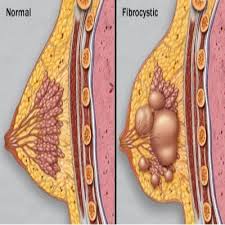 Fibrocystic breast changes is a condition of the breasts where there may be pain, breast cysts, and breast masses.
Fibrocystic breast changes is a condition of the breasts where there may be pain, breast cysts, and breast masses.
It is not a disease but represents normal breast changes.
The breasts may be described as lumpy or doughy.
Up to 50-60% of women without breast disease have histologic changes of fibrocystic pattern.
Affects 50-90% of women (Rastelli A).
Imply no increased risk of breast cancer.
Prevalence of fibrocystic breast changes in women over lifetime vary widely in the literature, with estimates ranging from about 30 to 75% of all women.
Women between the ages of 30 and 50 are most commonly affected.
Symptoms may vary during certain parts of the menstrual cycle.
FCD lumps are most often found in the upper, outer sections of the breast, but can be found throughout the breast.
With FCD there may be a persistent or intermittent breast aching or breast tenderness related to periodic swelling.
Breasts and nipples may be tender or itchy.
Usually symptoms follow a periodic trend tied closely to the menstrual cycle.
Symptoms tend to peak in the days and, weeks before each period and decrease afterwards.
May be associated with fulness, swelling and heaviness of the breast.
Fibrocystic breast disease is not associated with cancer.
Multiple small cysts and an increasing level of breast pain commonly develop when a woman hits her 30s.
Larger cysts usually do not occur until after the age of 35.
Risk factors for fibrocystic breast disease:
Early age at first menstrual period.
Having children late or not having children.
Differential diagnosis includes breast cancer.
Patients may be asymptomatic, but many have progressive symptoms.
Pathologically, changes consist of proliferative changes, fibrosis and cysts.
Ultrasonic features range from predominately solid lesions reflecting hyperplasia, and fibrosis, to microcysts, to macrocysts with internal echoes that may be difficult to distinguish from solid masses (Shetty MK).
Ultrasonic features of a simple cyst include: well defined, circumscribed margins, without internal echoes, and have posterior acoustical enhancement (a whiter column deep to the mass).
Simple breast cysts on ultrasound should be assessed in all planes and must be thin, and may be round oval or lobulated, and may contain thin avascular septations.
On ultrasound a simple cyst lacks internal echoes and the posterior internal enhancement both suggest its contents is fluid.
Simple cysts are benign and need no further work-up.
Prognosis is good.
Diagnosis typically involves ruling out breast cancer.
Fibrocystic change includes: fibroadenomas, fibrosis, and papillomas of the breast.
Management may involve a well fitting bra, and pain medication.
Occasionally agents like danazol or tamoxifen may be used for pain relief.
Fibrocystic breast disease is characterized by the findings of fibrous tissue and a lumpy, cobblestone texture in the breasts.
These lumps are smooth with defined edges.
FCD lumps are usually mobile in regard to adjacent structures.
